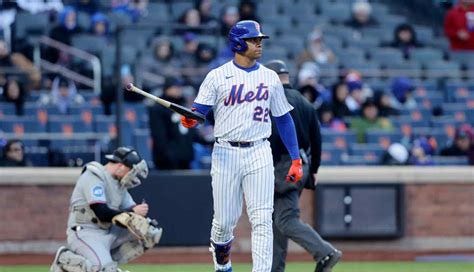The Mets are currently sitting on a winning record, have received solid pitching from their starters and bullpen, and have seen Pete Alonso perform at a level that we haven’t seen from him in a few years. Yet, there is still a $765 million dollar elephant in the room to start this season. Yes, Juan Soto has taken the route that all of his naysayers had hoped he would, and has begun his New York Mets career on an out-of-character note. It’s clear that his mechanics aren’t working right, and outside of the two home runs that he slugged in Minnesota, he hasn’t quite looked like himself in the box. Those intense, entertaining at-bats where he stares the pitcher down into submission have not yet made an appearance. To the naked eye, you can see that he is still mostly pulling the ball this season, and has not made use of the full field like he normally does. Does this mean all hope is lost for his success in Queens?
Of course not. Players, when signed for a large amount of money to a new team, sometimes struggle. Just ask Soto’s teammate, Francisco Lindor, about how his Queens tenure started. Soto’s early struggles are no doubt magnified by the weight of that contract, as well as how historically good he has been to start his career. So, since the Mets and Soto are locked together for the long-term, it’s important to find where exactly he has been struggling, and find ways to improve that. One spot to look at where there is a difference from last season is Soto’s bat speed. Last year, Soto’s bat speed was an elite 75.4 MPH, good enough for the 94th percentile of MLB hitters. This year, his bat speed has dropped to 72.8 MPH, which may seem like a minuscule difference, but drops him to the 66th percentile of batters.
A lot was made about Soto’s comments about hitting in front of Aaron Judge versus hitting ahead of Alonso. Soto is certainly seeing less desirable pitches to hit than he did last year. Last year, 49% of the pitches Soto saw measured either on the inside part of the plate, or too inside to hit the strike zone. This year, Soto is seeing 52% of the pitches land on the inside part of the plate, with a whopping 35% of the pitches he’s seeing come too inside for him to be called a strike. The clear visual bugaboo for Soto this season has been the up and inside pitch, which seems like the go-to pitch for the pitcher every time there are two strikes on him. If you tie in Soto’s bat speed issue this season, and the fact that he is increasingly being pitched up and in more often, a pitcher has a clear recipe for getting Soto to whiff. In fact, on the up and in pitches against Soto this season, his average bat speed drops dramatically to 70%, and he whiffs 33% of the time. When he is swinging at that pitch 33% of the time, you can see where issues might arise. Undoubtedly, a batting coach will have a session with Soto soon to go over increasing his bat speed, and shortening his swing on those pitches that are up and inside to him. When he adjusts more to that pitch being thrown at him more often, pitchers will have to move on and find a new way to try to get him out.
All of this of course is coming through a very limited sample size for Soto. The positives are that he is still drawing his walks at a great rate, and he is still striking out less than he is walking. He has shown some flashes of last season’s dominance with the home runs that he has hit. Lindor, upon his arrival in Queens, suffered worse struggles in the early parts of his first season. Through 21 games in his first season with the Mets, Lindor struggled to a .182 batting average, with a .297 on-base percentage and only one home run. Now, Lindor is a mainstay with the franchise, and is on pace to be one of the best shortstops in team history. Soto’s start, while not ideal, is not the worst that we have seen. When the team starts to play in better conditions more consistently, he will come around, and the trio of Lindor, Soto, and Alonso will make for an entertaining season.




Love that both Soto and Alonso have more walks than strikeouts. Soto has looked better since his standing ovation ahead of knocking in a big run. We’d all have preferred a monster start but at least his at bats have been strong. So now with Lindor and Soto heating up, if Alonso continues to hit well, he’ll have a ton of RBI this year. I guess we need to have more patience with him. While he signed the new contract that included a huge signing bonus, he did make $31 million with the Yankees last season, so it’s not like he already could have afforded whatever his heart designed.
He's walking slightly more and striking out fewer times - both good signs. On the other end, his ISO is down and his BABIP is pretty bad. He's really struggling against fastballs and his barrel% is way down.
Is that all a bat speed issue? I dunno - maybe. Guess I'm just not concerned about an elite hitter losing bat speed at age 26